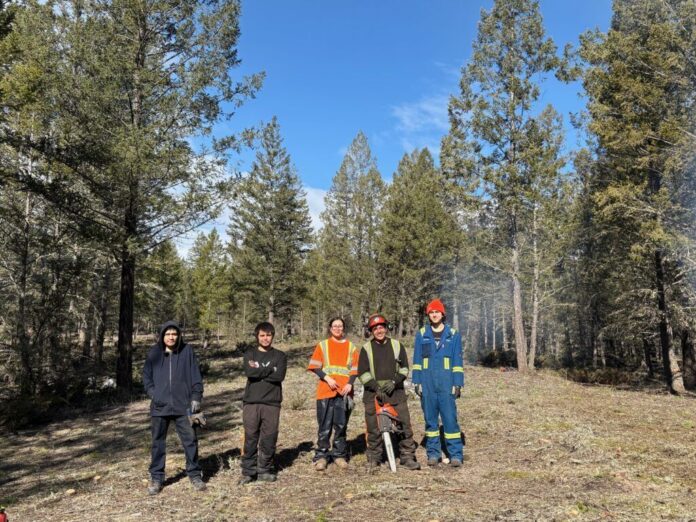The Shuswap Band completed an 80-hectare wildfire risk reduction project in the Juniper Heights area, east of Invermere.
The Forest Enhancement Society of BC (FESBC) says the project involved an initial effort to ensure investments toward reducing the heavy forest fuel load were not lost.
FESBC officials say the project was meant to build local First Nations’ capacity, provided environmental, social, and cultural benefits to the community, enhanced wildlife habitat, and presented opportunities for cultural burns in the future.
Work was supported by the FESBC and Kenpesq’t Forestry LP (Kenpesq’t).
“The Shuswap Band is proud to take part in this vital, Indigenous-led initiative in partnership with the Province of British Columbia and Kenpesq’t,” said Shuswap Band Chief Barbara Cote.
“By focusing on proactive and preventative measures, this program strengthens our collective efforts to mitigate the risks of future forest fires. It also provides a meaningful cultural learning experience that not only supports our community but contributes to the safety and well-being of the wider public, while ensuring the protection of all of our wildlife and plants for future generations.”
Juniper Heights is a residential area just outside of the Shuswap Band Reserve, and has previously undergone wildfire risk reduction treatment.
Since then, conifer trees have grown into open landscapes, such as grasslands.
“This shift in vegetation increased fuel loads and altered the landscape,” said Aaron Lee, Kenpesq’t Woodlands Manager.
“As such, Juniper Heights was an excellent candidate for renewed treatment—not only to enhance wildfire resilience but also to support the reintroduction of cultural burning practices in the future.”
Kenpesq’t conducted most of the work, which involved developing a plan, project management, organizing crews, supervision and submissions to their funder, the FESBC.
The FESBC says the job included manual cutting of small, immature trees, hand piling branches and forest debris and burning the piles.
“This work primarily entailed crews with chainsaws, cutting small diameter trees, bucking or cutting them into smaller pieces, and piling them to be burned. The trees cut were not ‘merchantable’, meaning they were not large enough to turn into dimensional lumber,” said Travis Emsland, Registered Professional Forester and Operations Manager with FESBC.
The FESBC provided $622,520.97 for the project, which included the preliminary field reconnaissance and wildfire risk reduction surveys, cutting, piling and burning, and grass seeding old burn pile locations to minimize the proliferation of invasive plants in the exposed soil.
“FESBC is a vital source of funding at a time when climate change is accelerating, and effective wildfire risk reduction is more critical than ever for the safety and resilience of our communities,” said Lee.
“Working with their Operations Managers has been a great experience. They’ve been great to collaborate with, bringing valuable knowledge and a strong understanding of the importance of these projects and First Nations involvement.”
The project was initiated by the Shuswap Band, which has been working toward increasing its workforce capacity.
“First Nations have been working very hard to get a foothold in the forest industry. We do this to make an impact from a Cultural and Indigenous Science approach to the management decisions that affect our Rights and Title on the landscape, but also to have economic opportunities previously withheld from us. Our role as Caretakers to our territories is an important one that Indigenous Peoples take seriously,” said Shuswap Band Councillor Mark Thomas.
“Shuswap Band is undertaking a wildfire risk reduction project on lands adjacent to our reserve. The intent is to limit the risk from forest fires, provide training, develop partnerships, and provide economic opportunities to the band and our member businesses. Shuswap Band is very proud of the work performed and intends to continue to capitalize on all aspects of forest management, from harvest to protection, inclusive of cultural values.”
So far, the FESBC says the work has reduced wildfire risk within the wildland urban interface area near Juniper Heights.
The project has made way for future cultural and prescribed burns.
“Wildfire risk reduction is a necessary step toward reintroducing cultural burning,” said Lee.
“Given the current state of the landscape and the areas that require burning, it’s an essential part of the overall process, and we are currently planning to conduct a cultural burn in the Juniper Heights project area.”
FESBC officials say this project also helped enhance wildlife habitats for species such as bighorn sheep, mule deer, white-tailed deer, and elk.
Their work has received recognition from the provincial government, as well.
“Wildfire risk reduction projects like this one, led by Kenpesq’t Forestr,y are exactly the kind of project we need more of: community-driven, and practical solutions that deliver economic, environmental, and cultural benefits today and for future generations to come. With support from the Forest Enhancement Society of BC, these efforts are helping First Nations-led forestry companies like Kenpesq’t create good family-supporting jobs,” Minister of Forests, Ravi Parmar.
“This is not just about reducing wildfire risk – these investments are laying the groundwork for long-term forest resilience, and stronger more resilient communities across the province.”
Lee says this kind of work with Indigenous nations will be vital to maintaining forest health.
“Cultural burning and meaningful collaboration with Indigenous communities will be fundamental to the success of future wildfire management strategies,” said Lee.
Be the first to know! Don’t miss out on breaking news and daily updates in your area. Sign up to MyEastKootenayNow News Alerts.




